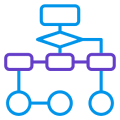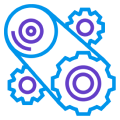The client is a global leader in medical technology, pharmaceutical diagnostics, and digital solutions. Its ecosystem revolves around digitizing healthcare and driving productivity to improve outcomes for patients, healthcare providers, health systems, and researchers around the world.
The client’s sales journey begins with the CPQ process that involves configuring the product, pricing it, and sharing the quote with prospects. Being a global player with large institutional clients, their CPQ process is quite complex.
The complexity begins with the configuration process.
End-to-End Configuration Process Flow

Configuring the right product option onto Salesforce across a large number of possible variables is not easy as it deals with a variety of medical equipment, price points, and technical specifications. And when discounts, promotions, region-specific rules and compliance are added to the mix, the whole configuration process becomes complicated.
To simplify the configuration process for its sales teams and prospects, the client integrated Salesforce with Apttus (including Conga). The integrations helped them accommodate their ever-evolving sales process dynamics, enabling them to:




Defects in such business-critical systems are extremely costly and can have severe consequences. Therefore, validation of each step, and every feature across this complex configuration was obviously crucial. That said, end to end testing of Salesforce with Apttus CPQ to ensure stable and error-free experience to all stakeholders was the ultimate team mission.
Increased Complexity Due to Multiple Integrations
The client’s dynamic sales process is held together by Salesforce CRM which integrates with multiple other systems and architectures. This makes end-to-end testing very difficult.
Inherent Test Automation Complexity of Salesforce
A powerful platform like Salesforce has multiple technical challenges to make test automation reliable. These challenges include shadow DOMs, heavy DOM structure, hidden as well as dynamic UI elements, and test data management. Automation frameworks built over a period of time lead to unsteady test automation and cannot cut through this complexity and hence fail to deliver their promise of successful test automation.
Frequent Salesforce Releases
In this global implementation program, there were three major releases a year (Spring, Summer, and Winter). This means that these updates have to be continuously tested prior to deployment into production across all regions. This increased the workload of testers as they had to manually write a new code every time to update automation suites to be ready for each release.
Limitations of the Existing Automation Framework
Framework built using Selenium had multiple limitations. It was extremely inflexible, and maintenance could not cope up with the speed of multiple releases. This led to higher costs and 80% of the defects were still slipping into the UAT environment.
Multiple Testing Environments
Being a global leader, the client had multiple implementation tracks for different global regions to cater to their specific requirements. This multiplied by various environments like dev, QA, staging, and UAT for each version and track, where testing was to be performed. As a result, the speed and quality of testing cycles were affected. This also increased the cost of testing that involved a large number of regression and acceptance test executions during short release cycles.
The client team evaluated Qualitia against these challenges and was impressed with the unique benefits it offered as a solution. The key factors that helped them make the switch to Qualitia include:
End-to-end Testing
Cuts through Salesforce’s complex workflows and integrations across web, API, and databases to cover all functional areas while providing business continuity assurance.
Auto-healing Technology
Makes maintenance a breeze by effectively dealing with Salesforce’s changing UI elements and ensuring test execution success.
Modularity
Enables independent test components to be reused across scripts and projects, facilitating faster adoption of changes, thereby slashing costs, time, and maintenance efforts.
In-Sprint Automation
Ensures shorter testing cycles and reliable testing that help arrest defects early while ensuring timely rollout of Salesforce seasonal releases and updates.
Scriptless Automation
Enables functional testers and admins to create test cases without requiring any coding knowledge.
Intelligent Reporting
Gives teams the visibility into changes that come with releases and provide them with actionable insights into the functionalities and tests that were impacted.
The Client’s Key Success Metrics
3 weeks to 7 hrs
80% automation maintenance effort saved through reusability.
The QA team now uses the saved hours to work on increasing coverage across all integrated environments.
Related Posts
As you land on our website, you might notice a notification about cookies. No, not the delicious kind that grandma used to bake, but the digital ones that help us improve your browsing experience. Don’t worry, you’re in control! You can manage your cookie preferences and decide which ones to allow. It’s like being the master chef of your own digital kitchen.